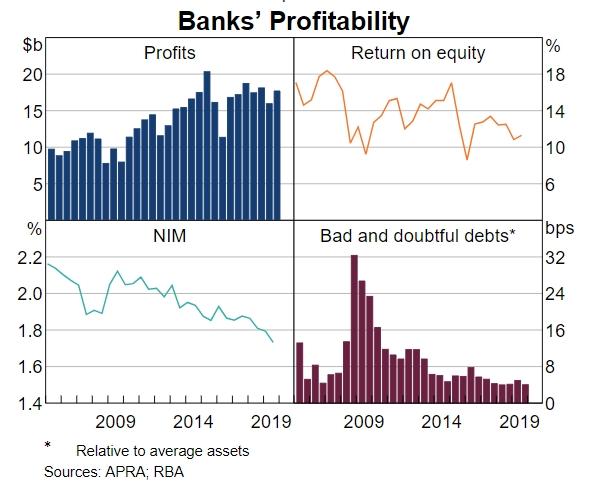The COVID-19 crisis combined with low interest rate environment for a sustained long period has created the perfect storm which, left unmanaged, could have significant impacts on banks’ earnings and capital. Interest Rate Risk in the Banking Book (IRRBB) is an area that is becoming increasingly important for banks to proactively monitor and manage in the current environment.
In this article, we discuss the key considerations for Australian banks during and post the crisis for prudent IRRBB management ultimately ensuring banks remain profitable and stable institutions while playing a key role in the economic recovery.
During a crisis like the one we are in; stability of the banking industry will be a crucial factor for a sustained recovery of the overall economy. Banks will play a major role by lending to businesses and households at lower interest rates to stimulate economic activity and also by partnering with the government in implementing some of its relief schemes.
However, at the same time it is very likely that the bad debts will increase to historical levels in the coming months and years. Therefore, issuing credit to stimulate the economy will become a delicate balancing act for banks.
Australian banks are relatively in a strong position compared to other banks in advanced economies globally going into this crisis.

This is due to a number of factors such as:
- Increase in deposits in 2019 and relatively lower accumulation of assets leading to higher LCR. Also, reduced reliance on replacing maturing bonds for funding in the current environment
- Historically low bad debt, most likely correlated to continued growth, wealth creation, immigration, mining, tourism & education boom
- ROE of Australian banks has been higher when compared to other international banks over the past few years. It was also significantly above their cost of equity (estimated to be around 9–10 per cent), despite the gap between the two narrowing as ROE drifted down over the past five years
- The narrowing of the NIM due to low interest rate environment has had less of an effect on Australian banks’ profitability compared to other advanced economies. This is because funding costs in Australia have been relatively cheaper than other economies. Funding costs on retail deposits are nearing zero. At the same time, wholesale funding has tended to go down below the cash rate. Wholesale funding in Australia is largely based on the BBSW rates. BBSW has been trending below the cash rate (cash rate represented in grey in Graph 2 below) recently.

However, COVID-19 has undoubtedly made it more challenging than ever to assess risks in the financial services sector.
The macro economic conditions evolving out of the crisis have never presented themselves in the past and as a result modelling risk based on historical data and assumptions is generating limited confidence amongst risk management professionals and in the industry as a whole.
The word “unprecedented” has been used time and again in the past few months and banks have had their fair share of this reflection in almost every facet of risk management as well.
For example, credit risk provisioning (with limited relevance of historical PDs) OR operational risk assessment (due to extended remote working environment) has never been more challenging.
In Australia, interest rates have been trending downwards for a decade now and household debts rising at the same time to record levels. In such an environment and with the COVID-19 crisis unfolding, it is increasingly crucial for banks to closely monitor the impact of projected interest rate movement on their earnings and capital under a wide range of macroeconomic scenarios.
Those impacts manifest themselves both directly through commercial margins as well as indirectly, through customer behavioural patterns adapting to the new normal as it unfolds.

There are 2 key areas that Australian Banks should pay close attention to when it comes to managing IRRBB in the current environment.
1) COVID-19 Impact on the Yield Curve

Australian government bond yield curve has been steepening over the past few months. In particular, the short-term rates have seen a significant dip post crisis. Despite RBA intervention both in terms of conventional as well as unconventional monetary policies, the curve is continuing to steepen. This could be due to multiple factors:
- The issuance of new government bonds drives down the yields in the short term
- RBA is also aiming to maintain a target of 0.25% for 3-YR bond yields. This included purchase of more than AUD 40 bn of government bonds from the secondary market in March 2020
- Steepening could also be a signal of a more optimistic prospects for the Australian economy in the longer term in comparison to other advanced economies. For example, the German curve has been flattening. The US/UK curve have seen a parallel down effect due to the pandemic.
- Global uncertainty can lead to increase in longer term yields as the term premium for bond yields go up
- Market response to potential long-term increase in policy interest rates and inflation
Generally, for Banks, steepening curves result in increase in profits due to their traditional business model of shorter-term funding and longer-term lending.
However, in Australia it may not necessarily be the case due to interest rates on majority of loans (e.g. variable rate mortgages) being based on the shorter term end of the yield curve.
In addition, the funding composition of major Australian banks is largely dependent on domestic deposits (as shown in Graph 5 below). Deposits play a key role in the IRRBB context especially given the uncertain nature of the impact of interest rate movements on the non-maturing deposit base such as current accounts and savings accounts.
Given the low interest rate environment and the importance of this deposit base on the Australian banks’ funding, regulators require banks to measure and monitor the impact of interest rate movements on this deposit base through modelling of deposits into core and non-core balances.

Given the growing importance of domestic deposits on the banks’ funding profile in Australia, a more comprehensive behavioural modelling into core and non-core deposit base in relation to interest rate movements is crucial in managing capital and earnings alike.
The challenge becomes even more outspoken while taking into consideration the vulnerability of interest rate revenues in a declining interest rate environment.
As mentioned previously, Australian banks have a relatively high concentration of variable rate loans compared to other advanced economies. Hence, interest rate declines translate into revenue decreases faster compared to international peers.
In general, the steepening of the yield curve as observed in recent times poses Australian banks to particular challenges in managing their capital and earnings due to the specific nature of their lending and funding composition.
The Dynamic Nature of the Yield Curve During the Crisis
On top of that, the general uncertainty introduced by COVID-19 crisis into the financial markets not only due to the uncertain economic outlook but also by the quantitative easing (QE) measures has led to a more dynamic nature of the yield curve.
The Graph 6 below highlights the movement in the yield curve pre and post quantitative easing carried out by the RBA and Government. There has been a general parallel down effect through the yield curve post QE announcement but what is interesting is the longer end of the curve rising post QE.
In such an uncertain environment it is important for Banks to consider all possible yield curve scenarios in assessing IRRBB.

Graph 6: Australian Yield Curve pre and post QE
In assessing the impact of the yield curves on their capital and earnings, banks are mandated to cover a wide array of yield curve scenarios for internal management.
The BIS promotes the use of a standardised set of interest rate shock scenarios in its attempt to promote international comparisons between banks.
To this end, the BIS outlines 6 prescriptive yield curve shocks that banks must consider (for each currency they operate in) in their EVE impact analysis. These are:
- parallel shock up (rates going up through the yield curve)
- parallel shock down (rates going down through the yield curve)
- steepener shock (short rates down, long rates up)
- flattener shock (flattening of the yield curve)
- short rates shock up
- short rates shock down
Given the vulnerability of the Australian banks in a low interest rate environment combined with increasing uncertainty, the overall measurement of the IRRBB across a wide range of scenarios on top of the regulatory scenarios will become a key focus of overall risk management for banks.
2) Cashflow Patterns During and Post COVID-19
In addition, the explicit requirements around modelling the customer behaviours along those interest shock scenarios pose a bigger challenge to many banks.
The contractual expected cashflow patterns have also been affected in the current environment due to government-initiated schemes such as repayment deferrals. Banks will need to adjust their expected cashflows to accommodate repayment deferrals but also their behavioural cashflow simulations in times like this.
Below are a few examples that highlight the changes in cashflow patterns that must be considered in IRRBB analysis.
Repayment Deferrals
As of mid-May, banks have deferred the repayment of one in 14 mortgages across the country bringing the total number of loans deferred to more than 700,000 with a value greater than $200 billion.
Customers opting for this also have the option of retaining the loan term or extending the term to repay the accumulated interest.

Graph 7: ABA Banking Update Mid May 2020
It is great to see Australian banks stepping up and assisting the country during these difficult times. However, banks have to factor in this unexpected shift in the cashflow patterns in the IRRBB analysis to assess both impact to their NII as well as EVE.
The systems used by banks have to be flexible to model these patterns which are inherently complex to emulate across multiple yield curve scenarios to thoroughly analyse the impact on the banking book.
Refinancing Spree on Mortgages
As per Australian Bureau of Statistics (ABS) data, the value of loans being refinanced increased by more than 50% in April compared to April last year. At the same time the number of new mortgages has decreased by almost 5% when compared to April last year. This behavioural pattern is certainly affecting banks’ cashflow models & forecasts.
Another key consideration is also a potential increase in fixed rate loans due to low interest rates as well as competitive products on offer in the market currently. For example, first 2 year fixed low interest rate loans offered by major banks could be an indication that banks are not anticipating rates going up in the near future.
Due to the overall competitiveness in the markets the conditions on new mortgage loans are so attractive (e.g. first 2 years fixed rate loans at historically low rates) that banks should anticipate a further increase in refinancing in the near future.
The above examples show that the impact of banks commercial strategies must be considered in IRRBB management. To this end, banks will need to consider their dynamic balance sheet composition to factor in the changing market dynamics and possibility of new products being introduced in the future.
This type of modelling also needs to include supporting government schemes such as the $1.3bn new loan guarantees in mid-may backed by the government (as shown in ABA figures above in Graph 7).
Increase in At-call Deposit Accounts Compared to Term Deposits
As mentioned previously, domestic deposits constitute the largest portion of banks’ funding and over the past couple of years there has been a general shift from term deposits to at-call deposits due to lower interest rates.
This is likely to be exacerbated during a crisis due to the general tendency for both corporates and households to have assets that can be easily liquidated.

Modelling at call or non-maturing deposits is particularly complex. BASEL outlines certain rules / guidelines around modelling this into the IRRBB risk analysis.
Here’s an excerpt from the BASEL norms for IRRBB that highlights the complexity & considerations for assessing the impact.
“Behavioural assumptions for deposits that have no specific repricing date can be a major determinant of IRRBB exposures under the economic value and earnings-based measures. Banks should document, monitor and regularly update key assumptions for Non maturing deposits (NMD) balances and behaviour used in their internal management systems (IMS). To determine the appropriate assumptions for its NMDs, a bank should analyse its depositor base in order to identify the proportion of core deposits (i.e. NMDs which are unlikely to reprice even under significant changes in interest rate environment). Assumptions should vary according to depositor characteristics (e.g. retail/wholesale) and account characteristics (e.g. transactional/non-transactional).”
Conclusion
The COVID-19 crisis has resulted in a steepening yield curve with a lot of uncertainty on the horizon. This in itself puts pressure on earnings and capital to all the banks globally but Australian banks have some specific vulnerabilities as discussed above.
In addition, lower interest rate environment and higher uncertainty is also triggering unexpected behavioural changes such as increased refinancing and freeing up cash by switching from term deposits to at-call deposits.
Both the direct impact of this new interest rate environment and the indirect impact of behavioural changes are having an impact on earnings and capital of banks. The combined effects of this have their specific dynamics in the Australian context whereby decline in shorter term interest rates has potentially a larger impact on profitability.
Banks’ commercial strategies in response to COVID-19 crisis might exacerbate these impacts by further incentivising refinancing behaviours. There is also volatility on the funding side due to the inability to attract funding commitments over a longer period of time especially given Australian banks being heavily dependent on domestic deposits for funding.
In these circumstances, the measurement of IRRBB under a large number of scenarios should be part of the banks’ internal risk management strategy as much as driven by regulation.
This article was co-authored by Piet Mandeville from ElysianNxt and Subu Hebbar from RegCentric. RegCentric is a leading Australian consulting company, specialised in transformation in Data Management, Finance, Risk Management and Regulatory Reporting in the financial services industry. The RegCentric team consists of highly experienced business and technology consultants who are passionate about assisting Australian financial services companies leverage technology to drive efficiencies, deliver insight and ensure regulatory compliance.




